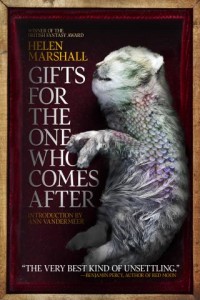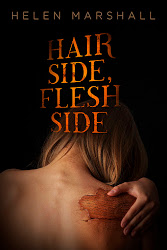
One of my favourite people – who also happens to be one of my favourite authors – is Helen Marshall … and lo! She has a new collection out, which is always cause for rejoicing and opening bottles of bubbly substances. Gifts for the One Who Comes After is the latest release from the wonderfully punchy indie press, ChiZine Publications. Helen took some time out from looking at medieval manuscripts at Oxford to chat about writing, what comes next, and covers that are adorable but ever-so-slightly wrong.
Don’t just take my word for it – Neil Gaiman, the father of us all, says: “Helen Marshall is a writer who creates real people in real situations, then uses the fantastic to pry her way inside her readers’ ribcages and break us wide open.”
1. Excellent title – how did this latest collection come about?
I started writing the stories that would be included in Gifts for the One Who Comes Afterwhile I was at the Clarion West Writers Workshop in Seattle. The workshop lasted six weeks, and we had to keep up with the punishing schedule of producing a story a week, which would be critiqued by genre notables including George R. R. Martin, Connie Willis, Chuck Palahniuk, and Kelly Link. After the workshop was over, the organizers give a warning that students sometimes suffer burnout and spend the next six months absorbing what they’ve learned but not writing. I didn’t want that to be me, so when I got home I immediately set to work on another story. And then another. And then another. That being said, I find a collection only starts to gain a shape once I’ve written about ten or so stories, enough to start finding commonalities and shared themes—a core. For Hair Side, Flesh Side, that core had been easy: it emerged out of the research I did for my doctoral studies on medieval manuscripts. I knew I wanted to talk about art and history, the Big Stuff. But this book was different. Around the time I was at the workshop, my nephew was born. I found myself writing stories about parents and children, about families, about the way we struggle with the idea of leaving a very personal legacy behind. That’s what this collection is about.
2. Dead kittens – talk us through the cover.
Yeah, dead kittens. Phew. One of the great things about ChiZine Publications is that they have always taken risks with their covers: the first cover I remember seeing was for David Nickle’s eerie collection Monstrous Affections, which features a man’s head with a bizarrely distorted grin. People found that cover so unnerving that once a friend of ours was asked by airport security to put the book away. So. The first version of the cover I saw was simpler: a very striking image of what looked like a drowned white tiger cub on a red background. I loved it. Genuinely loved it. To me the image was sad and sweet and a bit odd—a perfect summation of the book. It also represented a moment in a story called “In the Time of Omens” in which a young girl discovers this drowned kitten-thing in the trash and she keeps it in a music box her father gave her. But that cover pushed people’s buttons, and so we decided to draw on more of the fantastical elements of that story while keeping the basic image. To do this, Erik Mohr, the artist, added the music box as a frame and also added fish scales to the kitten. The conversation about the fish scales was pretty amusing because it involved feedback like: “No, that looks more like a pike, we need a prettier fish, like a trout? Like a rainbow fish maybe?” I can imagine any other artist slamming his head against his desk, but Erik took it like a pro and he produced an extraordinary image which, while still provocative, has lost some of the “Ugh! Dead kitten!” factor. If you’d like to see the evolution of the cover, Erik Mohr did a short piece for Quill&Quire which has pictures of earlier versions.
3. How does Gifts differ from Hair Side, Flesh Side? What elements are the same? 
I see Gifts for the One Who Comes After as an interesting extension of Hair Side, Flesh Side. You’ll find the same sense of oddness running through both collections, the same general sensibility, but I truly think the new collection is warmer and perhaps a bit more compassionate. The stories are more personal and a little less academic. And I know more. I’ve had more time to practice my craft and I’ve learned from some very clever people.
4. Do you envisage a time when you might give up short fiction and dedicate yourself to long form?
I feel like short story writers are always called upon to declare their allegiance to the short story form, just as horror writers are always asked to declare their allegiance to horror. It’s a little silly. Short stories do something very different from novels. The form shapes the rules of the narrative. You can do anything you want and you don’t really need to provide the larger framework of justification necessary for a novel. In a short story, I can say to you: “There once was a man with the same face as the Statue of Liberty.”; or “There is a country in South America where people ride skateboards on their backs because the gravity is too strong for them to stand up.”; or “I know a place where mittens fall in love.” It is much harder to maintain the surreal in a longer form; realism and believability exert too great a pressure. I’m finding that now whenever I work on my novel. Short stories are like an escape hatch where I get to say, “Right! Now I can do whatever I want. What’s the weirdest thing I can imagine? Let’s go with that.”
 5. And, of course, are you working on a novel? Tell us all about it.
5. And, of course, are you working on a novel? Tell us all about it.
I’m currently at work on what I’ll tentatively describe as a young adult novel called Icarus Kids about grief and transformation. Icarus Kids takes its inspiration from a passage from Aristophanes’ play, The Birds:
…the lark was born before all other creatures, indeed before the Earth; his father died of sickness, but the Earth did not exist then; he remained unburied for five days, when the bird in its dilemma decided, for want of a better place, to entomb its father in its head….
Singer and songwriter Laurie Anderson calls this moment the birth of memory. Icarus Kids hinges upon this image of death and reincarnation, of memory and trauma, and of what I like to think of as a “beautiful apocalypse”. That’s all I’m going to say about it for now.

